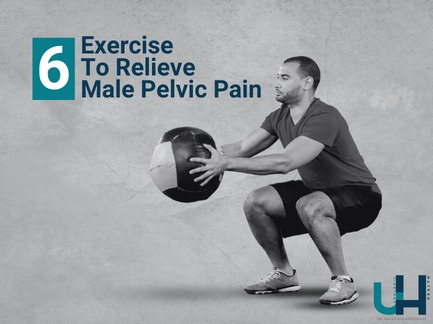
6 Exercises To Relieve Male Pelvic Pain
Thus, the pelvic floor can be referred to as a type of sling with the bladder, intestines, and reproductive organs situated on it. It is required for passing urine, having bowel movement and sexual activity.
To improve bladder and bowel control and relieve pelvic pain, pelvic floor exercises are performed. They prevent pelvic organ prolapse caused by weak pelvic additional muscles.
Unknown actors in your body, the primary functions of the muscles include holding and controlling all smooth movements of your body. Therefore, exercise and maintenance are very influential when it comes to health.
Pelvic Pain Causes
- Pelvic pain can stem from various sources,
- Hyperactive pelvic floor muscles
- Tension in pelvic floor muscles
- Stress
- Recurring infections
- History of sexual or emotional trauma
- Conditions like endometriosis, fibroids, or prostatitis
- Pregnancy or childbirth
- Scarring
- Tailbone injuries
- Hormonal imbalances
- Dietary factors
Pelvic pain is a complex issue, often influenced by a combination of these factors. Consulting a urology doctor or health practitioner is crucial to pinpointing the underlying causes of your symptoms. If you are showing any of the symptoms listed, it is recommended to consult a pelvic floor specialist in your area. They can offer personalised support and help as needed.
What Are Pelvic Floor Exercises?
Maintaining the muscles supporting your pelvic organs strong and flexible depends on pelvic floor exercises—physical treatment for pelvic congestion syndrome. Commonly used with these exercises, kegels also comprise multiple motions meant to tighten and relax the pelvic floor muscles.
You will identify these muscles by acting the same way you are trying to stop midstream for urinating. These exercises should not be done while urinating, though, since this may disrupt bladder functions and might lead to urinary tract infections.
Now onto some of the pelvic floor strengthening activities you could perform for male pelvic pain. Men at home can deal with male pelvic pain by doing pelvic floor strengthening exercises, which are highly important for pelvic health
Pelvic Floor Strengthening Exercises To Relieve Male Pelvic Pain
Here’s a set of exercises recommended by Prendergast:
Exercise 1: Core Breath
- Lie on your back with the knees bent.
- Slowly and deeply inhale through your nose feeling the air deep in to belly.
- Engage your pelvic floor as you exhale, drawing the belly button in towards spine
- Continue this breathing pattern, noticing how your pelvic floor muscle engages and releases.
- This move should be done every day and you can add up the repetitions as you get stronger.
Exercise 2: Knee Squeezes
- Main workoutLie on your back with knees bent and have feet hip width apart.
- Put a tiny cushion in between your knees.
- Squeeze your knees into the pillow – exhaling as you gently do so engaging both of those inner thighs and pelvic floor.
- Pause a few seconds, and then relax.
- Then slowly as you advance, do this again for 3 sets each of 10 repetitions a day.
Exercise 3: Thigh Rotations
- Lie on your back with knees bent and a resistance band around your thighs.
- Keep your feet together.
- As you exhale, gently rotate your thighs outward against the resistance of the band, engaging your pelvic floor muscles.
- Relax and repeat for three sets of 10 repetitions daily, focusing on smooth and controlled movements.
In addition to these specific pelvic floor therapy for male, incorporating core exercises into your routine can further support pelvic floor strength. Consider adding exercises such as planks, squats, lunges, and hip bridges to your workout regimen to enhance overall pelvic stability and function.
Pelvic Floor Relaxation Exercises
Let’s explore a simple pelvic floor exercise:
Pelvic Floor Drop & “Ass to Grass” Squat:
- Start by lying on your back or sitting in a deep squat.
- Imagine a balloon in your lower abdomen.
- Inhale deeply, expanding the balloon downwards.
- Exhale, relaxing back to your starting position.
- Stand with wide feet, toes out, and lower into a deep squat.
- Use a wall for support if needed.
- Take deep breaths for 5-10 counts.
- Repeat these movements multiple times daily, focusing on relaxation and controlled breathing.
Let’s try another pelvic floor exercise:
Exercise 2: Restful Deep Squat
- Position your feet hip-width apart with toes slightly pointed outward at first.
- Keeping your buttocks slightly above the ground and between your heels, lower yourself into a deep squat until you are gently seated.
- Till you discover a natural posture, change the distance between your feet such that both feet are firmly on the ground.
- Focus on releasing the muscles in the lower body while you slow and deeply breathe.
- Keeping this posture for 30 to 90 seconds, be aware of any pain and discontinue if necessary.
3rd one: Child’s Pose
- Start by kneeling on the floor.
- With feet together and knees apart, gradually back up onto your heels.
- Lean forward to let your forehead touch the ground and your chest to rest on your thighs.
- Either behind your back, by your sides, or extended out in front of you, find a comfortable posture for your hands.
- Holding this position, take calm, deep breaths for 30 to 90 seconds.
- Should you feel uncomfortable, softly release from the position.
Insider's Takeaway
If you’re dealing with pelvic pain or leaks, don’t worry! Pelvic floor exercises can help you feel better. They’re easy to do and don’t need any fancy equipment. Just do them regularly, and you’ll start feeling improvements. It’s like having a secret way to feel better, right when you need it!
